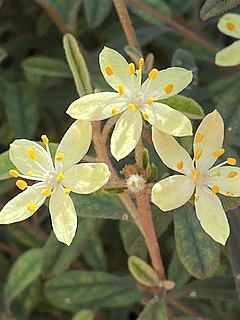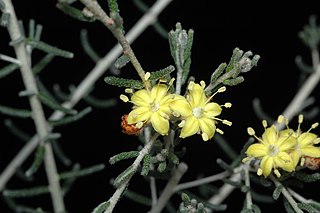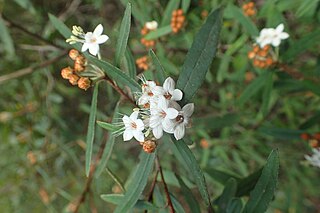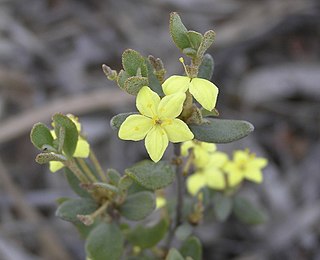
Phebalium squamulosum , commonly known as scaly phebalium or forest phebalium, is a species of shrub or slender tree that is endemic to eastern Australia. It has smooth branches covered with rust-coloured scales, linear to elliptical or egg-shaped leaves with the narrower end towards the base, and pale to bright yellow flowers in umbels with rust-coloured or silvery scales on the back.

Phebalium nottii, commonly known as pink phebalium, is a species of shrub that is endemic to eastern Australia. It has branchlets with silvery scales, oblong to elliptical leaves, deep pink to mauve flowers arranged in umbels of up to six, with the stamens distinctively offset to one side of the flower.

Asterolasia asteriscophora, commonly known as lemon starbush, is a species of slender, erect shrub in the family Rutaceae and is endemic to southern continental Australia. It has woolly, star-shaped hairs on its young branches, variably-shaped leaves covered with brownish or whitish hairs on the underside, and yellow flowers with woolly brown, star-shaped hairs on the back.

Asterolasia elegans is a species of slender, erect shrub that is endemic to a restricted area of New South Wales. It has dense, woolly, rusty star-shaped hairs on its stems, lance-shaped leaves densely covered with white and rust-coloured hairs on the lower surface, and white flowers arranged singly or in groups of up to nine in leaf axils or on the ends of branchlets, the back of the petals densely covered with woolly, white hairs.
Phebalium appressum is a species of shrub that is endemic to the southwest of Western Australia. It is more or less covered with silvery scales and has egg-shaped to heart-shaped leaves pressed against the stems, and flowers with rust-coloured scales on the pedicel. It is only known from the type specimen.
Phebalium brevifolium is a species of small shrub that is endemic to Western Australia. It has warty branchlets, sessile, wedge-shaped leaves and up to three white flowers arranged in umbels.
Phebalium laevigatum is a species of erect, slender shrub that is endemic to Western Australia. It has glandular-warty branchlets, linear to narrow oblong leaves and white or yellow flowers arranged in umbels of about seven on the ends of branchlets.

Phebalium lowanense, commonly known as the Lowan phebalium, is a species of slender shrub that is endemic to southern continental Australia. It is more or less covered with silvery and rust-coloured scales and has leaves appearing to be cylindrical, and yellow mauve flowers in umbels on the ends of branches.

Phebalium obcordatum, commonly known as the club-leaved phebalium, is a species of shrub that is endemic to New South Wales. It has smooth branchlets, small egg-shaped to heart-shaped leaves with the narrower end towards the base and small umbels of pale yellow flowers with silvery scales on the back of the petals.
Phebalium obovatum is a species of spreading shrub that is endemic to Western Australia. It has thick, egg-shaped or elliptical leaves densely covered with silvery scales on the lower side and white flowers arranged in umbels with silvery or rust-coloured scales on the back.

Phebalium speciosum is a species of shrub that is endemic to a restricted area of New South Wales. It has branchlets covered with rust-coloured scales, lance-shaped to narrow elliptical leaves covered with silvery and rust-coloured scales, and umbels of white to pale pink flowers with silvery or rust-coloured scales on the back of the petals.
Phebalium verrucosum is a species of shrub that is endemic to New South Wales. It has branchlets densely covered with white scales, narrow elliptic, oblong or linear leaves covered with white scales on the lower side, and umbels of creamy white flowers with silvery or rust-coloured scales on the back of the petals.

Phebalium woombye, commonly known as wallum phebalium, is a species of shrub that is endemic to eastern Australia. It has branchlets covered with scales and star-shaped hairs, elliptical leaves, and white to pink flowers arranged in umbels of four to ten flowers.

Asterolasia beckersii, commonly known as Dungowan starbush, is a species of erect shrub in the family Rutaceae and is endemic to a restricted area of New South Wales. It has woolly, star-shaped hairs on its branchlets, egg-shaped to lance-shaped leaves with the narrower end towards the base and covered with star-shaped hairs, and white flowers arranged singly in leaf axils, the back of the petals covered with star-like hairs.
Asterolasia buxifolia is a species of spindly shrub in the family Rutaceae and is endemic to a restricted area of eastern New South Wales. It has star-shaped hairs on its stems, leathery leaves and yellow flowers arranged singly in leaf axils with star-shaped hairs on the back of the petals.

Asterolasia correifolia is a species of erect shrub that is endemic to eastern Australia. It has white to brown star-shaped hairs on its stems, lance-shaped to elliptical leaves densely covered with white star-shaped hairs on the lower surface, and white to cream-coloured or yellow flowers arranged in umbels of four to ten or more in leaf axils, the back of the petals densely covered with white hairs.

Asterolasia drummondii, commonly known as Gairdner Range starbush, is a species of small shrub that is endemic to a restricted area of the southwest of Western Australia. It has egg-shaped leaves and white flowers arranged in umbels of five to ten flowers with rust-coloured, star-shaped hairs on the back of the petals.

Asterolasia grandiflora is a species of weak, open shrub or sub-shrub that is endemic to the southwest of Western Australia. It has oblong, elliptical or egg-shaped leaves and pink to mauve flowers arranged in umbels of about three flowers with a thick covering of star-shaped hairs on the back of the petals.

Asterolasia rupestris is a species of erect shrub that is endemic to New South Wales. It has heart-shaped to triangular leaves with the narrower end towards the base, and densely covered with star-shaped hairs. The flowers are yellow and arranged singly or in groups of three to six in leaf axils or on the ends of branchlets, the back of the petals densely covered with rust-coloured, star-shaped hairs.

Asterolasia squamuligera, commonly known as yellow starbush, is a species of erect, woody, slender perennial shrub that is endemic to the southwest of Western Australia. It has leathery, egg-shaped leaves with the narrower end towards the base and yellow flowers arranged in umbels of five to ten with a fringe of scales on the back of the petals, and about ten stamens.














